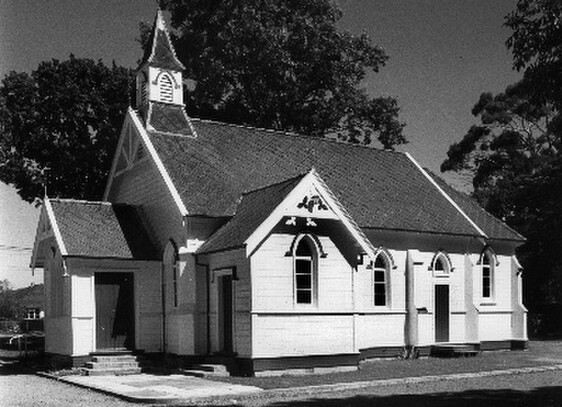St Johns
St John's Trentham, is the oldest church in the Anglican Diocese of Wellington that has been used continuously for worship since it was built in 1863. St John's Church is a Category 2 Historic Place. Julia Stuart, esteemed journalist and renowned local historian is the wife of Peter Stuart who was Vicar of St Johns 1982 to 1995, has given us permission to provide access to the pdf version of her publication, St John’s Anglican Church, Trentham 1863-2013, Mother Church of the Upper Valley. This gives an account of the origin, construction and expansion of St Johns, the parish and its community setting, for the past 150 years.
In 2022 the Church upgraded the foyer to include a kitchenette and modernised bathroom. We also replaced the carpet, had the rimu pews converted into more flexible chairs and installed TV screens to replace the overhead projector.
St John's Church History
This material has been abstracted from the booklet "Our First Hundred Years..." published in 1961 on behalf of the Parish of Trentham, and is similarly dedicated to those who pioneered the work of this parish in the Upper Hutt Valley.
In the Beginning...
The area presently known as Trentham was originally a 100-acre farm belonging to Richard Barton, who had come to New Zealand from his former position as Supervisor to the Duke of Sutherland's estates in Staffordshire, then known as Trentham Hall. In 1846 the Bartons settled in Upper Hutt, and their house was named Trentham.
The Barton family memory lives on in the area, with Barton Road, Barton Avenue and an area of native trees called Barton's Bush, which is within the reserve now known as Trentham Memorial Park. Richard Barton was interred in the grounds of St John's Church, and there are also memorials to him in the form of brass plaques within the Church building.
The actual construction of the Church itself was overseen by the Rev Frederic Thatcher, who was a noted church architect of the time. The first Vicar was the Rev J E Herring, who visited on December 27, 1861 and performed his first baptism as Vicar on March 30, 1862.
The Rev Herring's tenure was quite short, and he was succeeded by the Rev Amos Knell on September 27, 1863. Earlier that year, in January, Mr and Mrs Barton had, according to local tradition, given the money to purchase the land on which St John's church now stands. In addition, Mrs Barton gave significant support, both financial and otherwise, to the later construction of a vicarage in 1894.
Consecration
The Rev E Thomas Abraham (not the Rev Charles Thomas Abraham, son of Bishop Charles JohnAbraham) served as a Deacon in charge of the parish from August 1865 to April 1868. By this time, the original central portion of the present church building was completed, but it was not until 17th December 1865 that Bishop Abraham consecrated the building and its church-acre.
In the years that followed, considerable development occurred in the area, with an increase in settlement encouraged by the railway line, completed through to Upper Hutt in 1876. In 1884, the chancel and sanctuary were added to the church building, and a Vestry was added in 1914. However, it proved difficult to retain clergy in the area, and for several periods in the latter part of thenineteenth century, the parish was without a Vicar, and parish life fell to a very low ebb.
New Life
In January 1903, the Rev Cecil J Smith arrived at Trentham, and proceeded to re-invigorate the parish and the local area. He held services at Kaitoke, Mangaroa, Wallaceville, Whiteman's Valley and Silverstream, as well as at other venues in central Upper Hutt. In August 1908 he was appointed to Otaki parish. However, the Parochial District of Upper Hutt continued to grow, and was finally elevated to full Parish status in 1946, by decision of Synod.
Growth
During the 1950's, growth at St John's was so significant that two major events occurred; the first was the enlargement of the church building by extending the sides, completed in 1955, and the second was the completion of the present Parish hall in the 1960's.
The only other change to the building at St John's has been the completion of a foyer in the 1980's, and the more recent replacement of pinex ceilings with gib, completed during 2004.
Needless to say, there is much more to the history of this parish than it is possible to include here; the contribution of many hundreds of faithful parishioners over more than one hundred and fifty years means that they are too numerous to name. However, their legacy lives on in the church today.
Parish Sub Division
As the population of the parish grew it was found necessary to form two other parishes within the original St John's Trentham parish.
Originally constructed on the site currently occupied by McDonald's restaurant, St Hilda's Church was built in April 1910, as part of the Trentham parish. This was divided into a separate Parochial District as the result of a Synod decision in 1951, and later became a parish in its own right.
St Mary's church in Silverstream was originally mooted at a meeting on November 8, 1919, but construction was delayed by the difficulties of raising funds and the building was not completed until March 1931. St Mary's is also now a parish in its own right.

